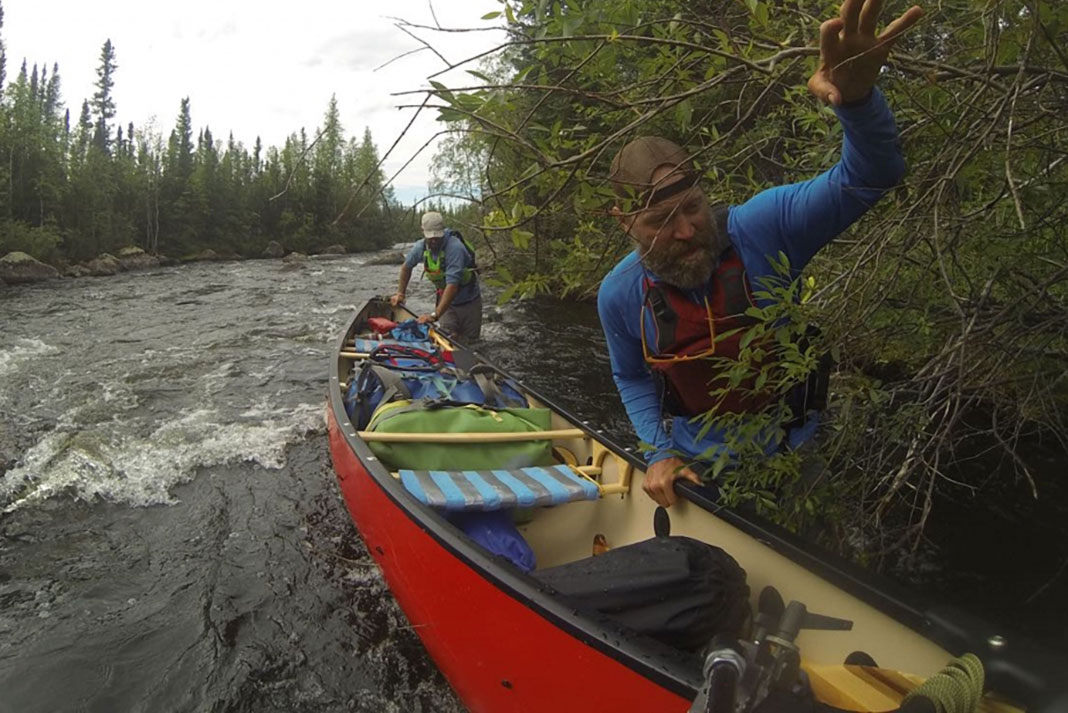When plastics conglomerate Poly-One shut down production of Royalex in 2013, canoe manufacturers scrambled to replace the favored hull material of whitewater and expedition paddlers. In Spring 2016, Esquif Canoes from Frampton, Quebec, began rolling out their line of T-Formex canoes and I was lucky enough to be one of the first to test the new product and provide my T-Formex review. Basically, I was their willing guinea pig.
Successor to the Royalex crown
Within the canoe industry, many manufacturers looked to composite materials as a Royalex replacement. Only one canoe company took on the gargantuan task of creating a hull material with the parallel properties of weight, durability and performance that Royalex possessed.
T-Formex looks, feels and acts like Royalex, with a seemingly indistinguishable ABS foam core sandwich construction.
Canoe tripping in the Canyon
To test the material’s durability and functionality, my friend Shawn Campbell and I set out from La Ronge, Saskatchewan in an Esquif Canyon on an 1,800-kilometer, 44-day journey to Baker Lake, Nunavut.
I’ve used prospectors as my hull design of choice for all of my expeditions since 2007, however Esquif hadn’t made any prospectors with T-Formex at the time of our departure. So I ended up using the Canyon—a whitewater tripping model that’s a hair shorter (16’5”) and has more rocker (4.5”) than the Esquif’s Prospecteur 17.
I was unsure about the new canoe model at first, since a large portion of our journey would be lake and upstream travel.
An immediate drawback was that the Canyon definitely required more correction strokes than the Prospecteur, but after a couple of days I got used to it. I ration out food for my canoe expeditions based on a 40-kilometer per day average, and in the end we were a little better than that number. So the combined upstream, downstream and lake speed with the Canyon was pretty much the same as with the Prospecteur.
Payload and maneuverability to spare
Our sole re-supply stop was 15 days into our trip at Lac Brochet, Manitoba, from where we paddled away with 30 days of food to the finish. The 1000-pound capacity craft easily absorbed our payload, leaving lots of freeboard. Though not as good at tracking in still water, the advantage of the Canyon over a prospector design became apparent in the whitewater and windy lakes on the second half of the tour.
The Canyon’s maneuverability was gauged in the tight confines of an unnamed river that flows from Nunim Lake and eventually to Kasba Lake. Characterized by narrow flumes that snaked around boulders and logs, the river required instantaneous manoeuvres in order to avoid getting hung up or worse. Even with a full load, the canoe stayed nimble and turned on a dime whenever we needed it.
We ran the entire thousand-kilometer length of the Kazan River as part of the route, and found that the Canyon rode really dry when running through the haystacks and holes of its high-volume rapids.
On big, windy lakes like Kasba and Ennadai, we paddled extended, exposed stretches in meter-high waves and the Canyon danced up and over the breakers with ease. Its deep bow was more effective at shedding water than a Prospector or asymmetric canoe. Overall, I found the Canyon to be a great river tripper that’s versatile enough to excel in any water conditions.
T-Formex Review: It’s a winner
As much as I enjoyed the Canyon, it’s the material that everyone asks me about. And as for my T-Formex review itself, I was impressed.
On our way to the divide at Nunim, we traveled upstream through a shallow creek system for several days, which often involving dragging the canoe fully loaded over rocks. From this experience, I definitely found T-Formex held up better than Royalex. It seems to be stiffer—not gouging as easily when being ground over sharp rocks or dragged through dense bush and rough tundra. Portaging with the canoe on my shoulders was no problem either—the spec weight is the same as Esquif’s previous models, which is great.
In order to truly test the durability of the material, we decided not to install Kevlar skid plates. Despite this, the wear on the bow and stern by the end of the trip was surprisingly minimal with no denting despite the endless hard hits the canoe took. As well, T-Formex slides easily over shallow boulders and ledges in rapids so property-wise, I found it to be as forgiving and predictable as Royalex.
In my opinion, lovers of Royalex should rejoice. It’s back and better than ever in the form of T-Formex. No need to handle your canoes with kid gloves any more—you’ll be beating the heck out of your T-Formex canoe for years to come.
More canoes in T-Formex coming soon
Long-term goals of Esquif include providing T-Formex sheets to all manufacturers who want them, so paddlers should look out for their favorite canoe brands to utilize this promising new material down the road. Keep a close eye on your local canoe retailer’s shelves and you too could do a T-Formex review.
